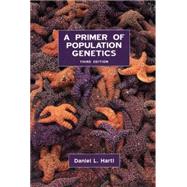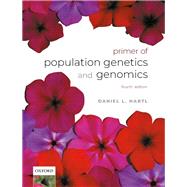A Primer of Population Genetics

A Primer of Population Genetics
- ISBN 13:
9780878933044
- ISBN 10:
0878933042
- Edition: 3rd
- Format: Paperback
- Copyright: 10/06/1999
- Publisher: Sinauer Associates is an imprint of Oxford University Press
- Newer Edition
Used From $59.50
Sorry, this item is currently unavailable.
List Price $81.01 Save $21.51
Used
$59.50
Usually Ships in 24-48 Hours
We Buy This Book Back!
Included with your book
Free Shipping On Every Order
Note: Supplemental materials are not guaranteed with Rental or Used book purchases.
Extend or Purchase Your Rental at Any Time
Need to keep your rental past your due date? At any time before your due date you can extend or purchase your rental through your account.
Summary
In response to many requests, A Primer of Population Genetics, Third Edition, has been dramatically shortened and streamlined for greater accessibility. Designed primarily for undergraduates, it will also serve for graduate students and professionals in biology and other sciences who desire a concise but comprehensive overview of the field with a primary focus on the integration of experimental results with theory. The abundance of experimental data generated by the use of molecular methods to study genetic polymorphisms sparked a transformation in the field of population genetics. Present in virtually all organisms, molecular polymorphisms allow populations to be studied without regard to species or habitat, and without the need for controlled crosses, mutant genes, or for any prior genetic studies. Thus a familiarity with population genetics has become essential for any biologist whose work is at the population level. These fields include evolution, ecology, systematics, plant breeding, animal breeding, conservation and wildlife management, human genetics, and anthropology. Population genetics seeks to understand the causes of genetic differences within and among species, and molecular biology provides a rich repertoire of techniques for identifying these differences.
The book is organized as a user's guide to population genetics. Chapter 1 starts with the basic concepts of molecular genetics and examines the principal methods by which DNA (or proteins) can be manipulated to reveal genetic polymorphisms in any population. Chapter 1 also includes the principles of population genetics underlying the organization of genetic variation in populations, with special emphasis on random mating, linkage equilibrium and disequilibrium, and inbreeding.
Chapter 2 examines the evolutionary processes that can change allele frequencies, including mutation, migration and population admixture, natural selection of various types, and random genetic drift. This chapter also includes an elementary explanation of the diffusion equations as used in population genetics.
Chapter 3 is the core of molecular population genetics. It includes the analysis of nucleotide polymorphism and diversity based on coalescents, patterns of change in nucleotide and amino acid sequences with special emphasis on codon usage bias and amino acid polymorphisms, inferences based on comparisons of levels of polymorphism and divergence, molecular phylogenetics, and the population dynamics of transposable elements.
Chapter 4 focuses on complex traits whose expression is influenced by multiple genes and environmental factors. It examines genetic effects on the components of phenotypic variation and the correlations between relatives, the evolution of quantitative traits in natural populations, and comes full circle with the use of molecular polymorphisms and candidate genes in the identification of quantitative trait loci underlying complex inheritance.
As for mathematical rigor, while there are some equations, the emphasis is on explanation rather than derivation. Only elementary algebra is necessary to follow most of the material, but a familiarity with basic calculus is helpful for understanding diffusion equations, Poisson random fields, and complex threshold traits. Mathematical symbols are used consistently throughout the book, and when results from the theoretical literature are quoted, the original symbols have been changed as necessary to maintain consistency.
Modern population genetics makes liberal use of acronyms--these are all defined in the text, and their interrelations and implications are discussed. For ease of reference there is a glossary of acronyms and other common abbreviations used in population genetics. The text also includes numerous practical examples showing how the theoretical concepts are applied to actual data, as well as chapter-end problems.
The book is organized as a user's guide to population genetics. Chapter 1 starts with the basic concepts of molecular genetics and examines the principal methods by which DNA (or proteins) can be manipulated to reveal genetic polymorphisms in any population. Chapter 1 also includes the principles of population genetics underlying the organization of genetic variation in populations, with special emphasis on random mating, linkage equilibrium and disequilibrium, and inbreeding.
Chapter 2 examines the evolutionary processes that can change allele frequencies, including mutation, migration and population admixture, natural selection of various types, and random genetic drift. This chapter also includes an elementary explanation of the diffusion equations as used in population genetics.
Chapter 3 is the core of molecular population genetics. It includes the analysis of nucleotide polymorphism and diversity based on coalescents, patterns of change in nucleotide and amino acid sequences with special emphasis on codon usage bias and amino acid polymorphisms, inferences based on comparisons of levels of polymorphism and divergence, molecular phylogenetics, and the population dynamics of transposable elements.
Chapter 4 focuses on complex traits whose expression is influenced by multiple genes and environmental factors. It examines genetic effects on the components of phenotypic variation and the correlations between relatives, the evolution of quantitative traits in natural populations, and comes full circle with the use of molecular polymorphisms and candidate genes in the identification of quantitative trait loci underlying complex inheritance.
As for mathematical rigor, while there are some equations, the emphasis is on explanation rather than derivation. Only elementary algebra is necessary to follow most of the material, but a familiarity with basic calculus is helpful for understanding diffusion equations, Poisson random fields, and complex threshold traits. Mathematical symbols are used consistently throughout the book, and when results from the theoretical literature are quoted, the original symbols have been changed as necessary to maintain consistency.
Modern population genetics makes liberal use of acronyms--these are all defined in the text, and their interrelations and implications are discussed. For ease of reference there is a glossary of acronyms and other common abbreviations used in population genetics. The text also includes numerous practical examples showing how the theoretical concepts are applied to actual data, as well as chapter-end problems.








